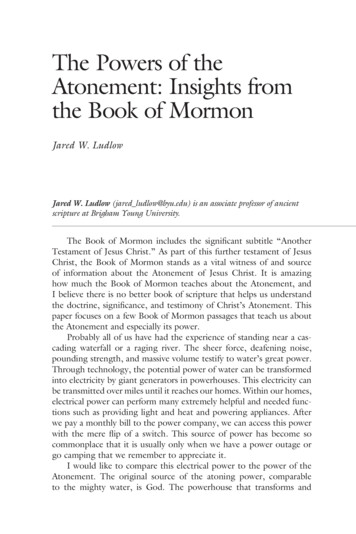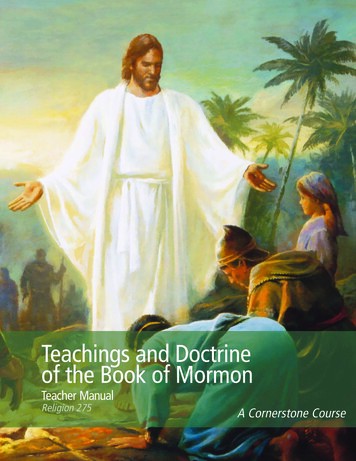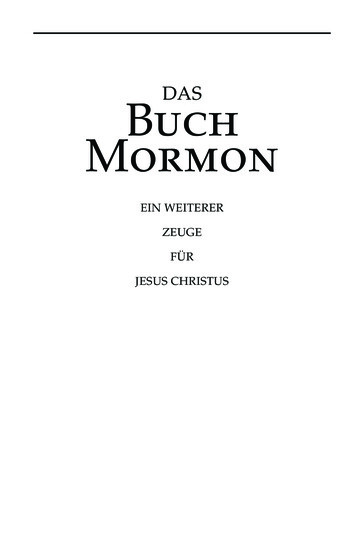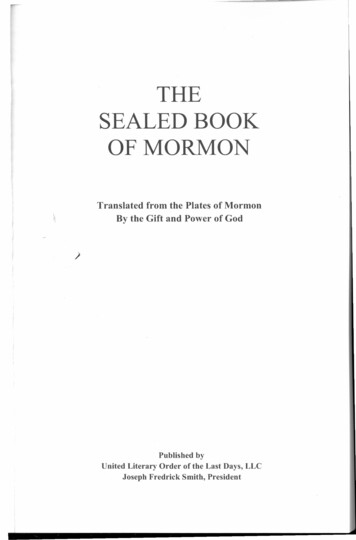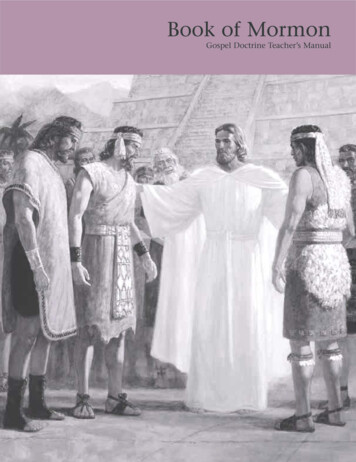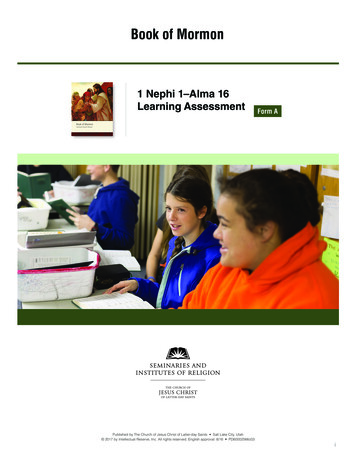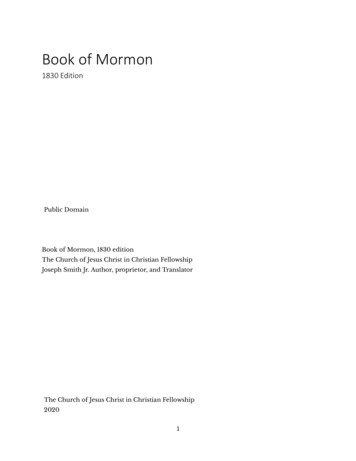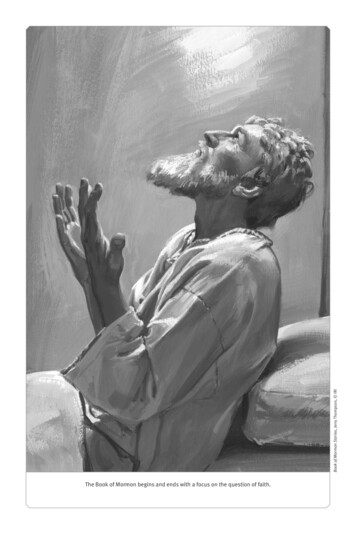
Transcription
Book of Mormon Stories, Jerry Thompson, IRIThe Book of Mormon begins and ends with a focus on the question of faith.
The Nephite Prophets’Understanding of Faithand Faithfulnessnoe l b. re yno ldsNoel B. Reynolds (noel reynolds@byu.edu) is a professor emeritus of political science atBYU.Readers of the Book of Mormon agree that faith in Jesus Christ is a basicprinciple of the gospel, or doctrine of Christ, taught therein. And theyagree, at least superficially, on the meaning of the word faith to the extentthat is allowed by their modern, westernized worldview and background inNew Testament Christianity. However, as I engaged in an in-depth studyof the gospel of Jesus Christ as the Nephites understood it, I realized that(1) our modern cultural understandings shield us from those of the Nephiteprophets in many ways, (2) the Nephite concept of faith is far from simple,and (3) the Nephites’ dependence on Old Testament covenantal conceptsconstitutes an essential dimension of their approach to faith in Jesus Christ.In this essay, I will reconstruct the Old Testament perspective as it relates toNephite understandings and then examine the full range of relevant Book ofMormon usage by trying to document and discover the meanings of faith inNephite discourse.The Christian world generally speaks of humankind’s relationship to Godin terms of faith as the “central term” defining that relationship and as “a basicsource of hope and inspiration.”1 Yet, as prominent Christian theologianRE · VOL. 21 NO. 2 · 2020 · 73–97 73
74Religious Educator · VOL. 21 NO. 2 · 2020Brevard Childs explains, “From the start the subject of faith has been thesource of great controversy. It not only served to define Christianity overagainst Judaism, but also was a major factor in separating Protestant belieffrom Roman Catholic during the period of the Reformation. Indeed, muchof the present confusion in today’s church rests on a widespread uncertaintyover the meaning and content of faith.”2 Much of that confusion arises fromproblems in scriptural interpretation: “How is one to explain the elementsof both striking continuity and discontinuity between the two testaments,especially in terms of the Old Testament’s peripheral use of the term faith incontrast to its centrality within the New Testament?”3Biblical Hebrew and Modern LinguisticsThe twentieth century produced developments in linguistic and textual studies of the Hebrew Bible that are particularly relevant for this inquiry. Themidcentury effort to apply the principles of scientific linguistics to studiesin biblical Hebrew produced significant challenges to traditional interpretations. Semanticists found important deficiencies in standard approachesthat gave too much weight to etymologies and cognate language studies. Butthose deficiencies also paid too little attention to the varieties of usage evidentin the Hebrew text. Some of the most effective critiques focused precisely onstudies of faith and faithfulness, severely criticizing the traditional methodologies used to produce them.4 By the end of the century, it was clear thatthe semanticists had won and that Hebrew Bible scholars had incorporatedthe insights of modern linguistics into their approaches to Bible dictionariesand textual studies.5 Though I will spare readers the details of these linguisticbattles, this essay will rely on the outcomes that now appear to be agreeableto most current Bible scholars.Two important caveats for contemporary readers emerge from thesestudies. First, the modern distinction between faith and knowledge has littleparallel in the Hebrew Bible. And second, all the faith-related terminology inthe Old Testament should be understood in the context of a preexisting covenant with the Lord. Faith and faithfulness are about relationships. Regardingthe first point, the basic linguistic fact to recognize is that biblical Hebrewhas no noun for faith. Rather, the semantic field on faith is filled with a groupof verbs about trusting or adjectives and nouns that derive from related verbs.According to Childs, “Faith in the Old Testament is always trust which isgrounded in past events of deliverance and salvation, but which awaits God’s
The Nephite Prophets’ Understanding of Faith and Faithfulness75future intervention as creator and redeemer.”6 In only two instances do theserefer to beliefs about what is true or false, as would most modern referencesto faith. Most importantly, the modern understanding of faith as beliefs thatcannot be adequately supported with facts or reasons would be foreign to theancient Israelite understanding. Biblical faith was not an epistemological issue.The second point —questions of faith raised issues of trust and freechoice. The question was always this: Did one’s actions demonstrate trustingin Yahweh (the Lord) or in something else? Tests of faith were tests of character and loyalty in a covenant relationship and not tests of the intellect. Actsof faith demonstrated loyal commitment to the Lord, trust in his covenantpromises, love of him and his people, and acceptance of his superior knowledge of what was best for his people. Choosing to trust instead in the wisdomof humans, idols, the power of armies, personal wealth, political power, orone’s own behavior preferences was to rebel against the Lord and his covenantand to become apostate.Faith as a Function of Israel’s Covenant with GodModern confidence in the vast potential of humans to master and controltheir world stands in stark contrast to the worldviews of premodern societies and to the understanding of ancient Israel as reflected in the writings ofthe Old Testament. The Hebrew Bible describes Abraham as a pastoralistwho inherited from his ancestors the understanding that God had createdthis world and had placed men and women in it, expecting them to obey hiscommandments. Further, because of his exceptional righteousness, Abrahamreceived direct revelation from God confirming his inherited beliefs. Butmost critically for all future self-understanding in Israel, Abraham was offereda unique relationship—a covenant between him, his people, and God thatwould shape their world from that point on. As the all-powerful creator ofthe world, Yahweh would adopt Abraham and his posterity as “his people.”They would be his family, and he would be their father and their God by covenant. As such, he would love, protect, and prosper them with the requirementthat they would take his name upon them, show their loyalty and reciprocal love for him by keeping his commandments, and love, protect, and helpone another as his children. By doing so, they would become the examplethat could show all nations how the one true God could and would adoptand bless any people, and they would become the means through which Godwould offer this same covenant and its blessings to all humankind.7
76Religious Educator · VOL. 21 NO. 2 · 2020By offering this covenant relationship to Abraham, his posterity, and ultimately to all people, Yahweh presented them all with a fundamental choice.Would they choose to accept direction from the creator of the world based onhis knowledge, values, and priorities for the conduct of their lives, or wouldthey choose to rely on their own wisdom, wealth, or sociopolitical power inpursuing self-chosen paths in life? Choosing Yahweh and his path wouldrequire trusting in his unfailing goodness, power, love, and promises without knowing how or when his promised blessings would come. Perhaps evenmore important, it would mean accepting his judgment about what was bestfor them. Rejecting the invitation to his covenant would leave people vulnerable to all their own weaknesses and imperfections and without any promisedaid from the Lord. And it would place them in a posture of rebellion againsttheir covenant father and God.Perhaps the most striking feature of Yahweh’s invitation was that it wasopen-ended. Anyone who had previously rejected or not known of the invitation could decide at any point to accept it. The concept of repentance in theOld Testament basically means to turn or return to the correct path, to thecovenant path laid out by the Lord for all his creations.8The certainty that Yahweh offered to Abraham and his descendants wasbased in his goodness and power as the creator of the universe and in his surelove for his creations—his determination to bless all people to the extent thatthey would allow through their own free actions.9 God’s faithful love for hischildren, combined with his comprehensive knowledge of all human possibilities, justify them in trusting him in all their choices and conduct. Men andwomen can place their trust in the Lord because he first loved them faithfully.God is the only reliable truth—the only certainty available to fallible humans.His promises are sure. And through his covenants, he provides the only paththat righteous men and women can follow to reach their highest potentials.The Fall and Rise of the Abrahamic Covenant in Biblical StudiesBy the middle of the twentieth century, Bible scholars were recognizing theAbrahamic covenant in Genesis as the principal unifying thread and plot linein the Hebrew Bible. They were also beginning to understand that the conceptof faith in God in the ancient covenantal context differed from that in biblical theologies developed since the last books of the Bible were written. Onenatural outcome of the marriage of early Christian theology and Greek philosophy was the distinguishing of faith as something less or different from the
The Nephite Prophets’ Understanding of Faith and Faithfulness77“true, justified belief ” that Plato and later philosophers had defined as the appropriate standard for human knowledge. Christian theologians had committedthemselves to philosophical doctrines and methodologies that inevitably ledto the conclusion that faith was a form of belief that could not or need not besupported with adequate facts or reasons. While theological debates producedcountless versions of this westernized understanding, none retained the ancientcovenantal view that the only reliable certainties for humankind derive from acovenantal relationship with the divine creator of the universe.John Gee has noted a related development in word meanings during thefirst two Christian centuries. Citing A Greek-English Lexicon, he offers threerelevant examples that “include the change of the principal meanings of pistisfrom ‘collateral, guarantee’ to ‘belief,’ of pisteuein from ‘to trust, rely on; entrust,commit, put up collateral’ to ‘to believe,’ of homologein from ‘to agree to terms,accept an agreement, enter into a legal contract, promise’ to ‘to confess.’”10Bible scholars today will usually point to the 1933 publication of WaltherEichrodt’s theological interpretation of the Old Testament from a Christianperspective and the 1961/1967 publication of the English translation of itssixth edition as major turning points in recognizing the fundamental role ofthe Abrahamic covenant in the Hebrew Bible and its influence in the NewTestament.11The midcentury efforts of a few Christian theologians to understandbasic religious concepts such as faith in a covenantal context were largely overshadowed by the dramatic discovery that ancient Hittite treaty- covenantsdisplayed clear similarities to Old Testament covenant texts and therebyprovided historians with obvious first and second millennium BCE candidates for the sources of the Hebrew texts.12 The treaty-covenant paradigmdominated biblical studies almost to the end of the twentieth century untilHarvard professor Frank Moore Cross and other scholars impressively demonstrated how the internal covenant language and ethos of Israel as displayedthroughout the Old Testament matched up even better with the earlierkinship-based social and legal structures of the desert tribes of the ancientNear East.13 Cross showed how these kinship-based tribes were held togetherby covenant structures and expectations through which unrelated outsiderscould be incorporated into kinship groups through marriage and adoptionsor as servants and allies—giving them equal rights and duties in the clan andincorporating the tribal deity as the father of his people. Further, he showedhow this kinship-by-covenant language and ethos permeates the writings of
Religious Educator · VOL. 21 NO. 2 · 202078the Old Testament. More recently, Scott W. Hahn has produced a satisfyingand holistic integration of Cross’s insights with the full range of biblical covenant studies.14Faith in a Covenant ContextBy the 1990s, most Bible scholars recognized that the covenantal basis ofIsraelite society required new interpretations of concepts like faith that differed fundamentally from the philosophical and theological tradition thathad produced modern Christianity. This is evident, for example, in the massive compendium of Bible scholarship published in the six-volume Anchor BibleDictionary. This dictionary’s article on faith explains that the “uniquely Westernview of faith” arose “in the context of the medieval attempts to codify and integrate the Christian experience into the emerging philosophical language of thescholastics,” quoting Thomas Aquinas as an example: “Faith is the act of theintellect when it assents to divine truth under the influence of the will movedby God through grace.”15 While the Greek term pistis, usually translated faith inthe New Testament, does “approximate the sense of faith as assent,” the HebrewBible does not have an equivalent term, but rather features a varied terminologythat is “much more elastic” in its range of meanings.16Interpreting Old Testament ʾemuna, he emin, and mn (aman)Well-known Latter-day Saint Hebraist Matthew L. Bowen summarized therelationships of the key Hebrew terms for faith and trust:Faith and praxis were inextricably linked in ancient Israelite thought. The Hebrewnoun ʾĕmûnâ—found in theologically significant passages like Habakkuk2:4—denoted not just “faith” but durative and perdurative “faithfulness” or “steadfastness” (in belief/trust) and personal “reliability.” Both ʾĕmûnâ and the relatedverb heʾĕmîn—“believe in,” “have trust in,” “have faith in” (the verb which occurs inthe theologically crucial statement about Abraham’s faith in Genesis 15:6)—derivefrom the root ʾmn whose fundamental meaning is “to be firm, trust worthy, safe”“to be sure” “to endure,” etc. (cf. the cognate Egyptian verb mn to “be firm,” “established,” “enduring”). These words imply the constancy and reliability of action(s)over time.17In 1953, Edmund Perry, a young Bible scholar at Duke University, helpfully undertook “the task of determining the full connotation of ʾemuna in itsOld Testament usage.”18 While the term is sometimes translated as “faith” (as inHabakkuk 2:4b RSV), “but the righteous shall live by his faith”) and more often“faithfulness,” Perry cited the Dorssen dissertation and the standard Hebrew
The Nephite Prophets’ Understanding of Faith and Faithfulness79lexicon to conclude that “the basic verbal meaning of the stem seems to be ‘tosupport, to carry, to hold, to care for.’”19 He cited examples of its various formswhere it describes a child being “nursed” or “carried,” or a person or thing “to befirm or steady” or “to be resolute or unchangeable.” But, he clarified, “this steadiness . . . is not the result of stabilizing oneself with one’s own resources” but “bytaking hold of or supporting himself on something or someone regarded to bestable and reliable.” This leads to the English translations of “trusting” or “believing in”: for example, Abraham “trusted the Lord (Genesis 15:6).”20Consistent with the methodologies promoted by mid-twentieth-centurysemanticists, Perry then went on to narrow these meanings by identifying thetwo words that are most frequently associated with ʾemuna in the HebrewBible—hesed (steadfast love) and tsedeq (righteousness). He first incorporated the previous work of Norman Snaith, who had identified twenty-fourpassages in which ʾemuna or its sister term emet (truth) are linked with hesedin rhetorical hendiadyses. He then added to these another nine referenceswhere ʾemuna and hesed occur in parallel constructions to conclude thatʾemuna “cannot mean less than ‘loving steadfastness, devoted dependabilityor trustworthiness.’”21 The translation “faithfulness” seems to preserve thesesame meanings. Righteousness (tsedeq) also occurs seven times in a parallelconstruction with ʾemuna. Other parallels closely associated with ʾemuna areyashar (upright), tamim (upright or perfect), and mishpat (justice), solidifying the close connection of ʾemuna and righteousness.22On the basis of these linguistic and textual studies, Perry proposed thatʾemuna has an active sense when applied to humans—they are expected totrust and obey the Lord—and a passive sense when applied to God, emphasizing that he is trustworthy. “The trustworthiness of God has a demandingeffect upon men to trust God. It is the trust of God’s trustworthiness whichmakes man trustworthy or justified with God. . . . ‘If you do not trust, you willnot be entrusted’ (Isaiah 7:9).” This trustworthiness is meant to be more thana quality of life or commitment. It is “a way of life, standing in polar contrastto the way of disobedience and deceit.”23 Because the Old Testament doestreat “trust” and “obedience” as alternative ways of satisfying God’s demandson his people, ʾemuna “comprehends the totality of what we commonlymean in the familiar expression ‘faith and works.’ . . . Only the obedience oftrust is reckoned to man as righteousness.”24The Hebrew root from which most faith-related terminology derives isthe verb aman.25 As Healey explains, it occurs in three forms: “In the Qal form
80Religious Educator · VOL. 21 NO. 2 · 2020it never means “believe” but expresses the basic sense of the root “to sustain,support, carry” (2 Kgs 18:16). The variety of occurrences in the Niphal formall “have the sense of firmness, stability, confidence (1 Sam 2:35, Deut. 7:9. . . ).” Only when it (he emin) occurs in the Hiphil with the preposition l doesit seem to mean “to hold something to be true, or to believe” (Genesis 15:6,45:26, Exodus 3:1–22, 4:28–31, and Isaiah 7:9).26 Even “in these instancesthe sense of trusting and having confidence is most noticeable. . . . A distinction is made in some authors (Pfeiffer) between ‘profane’ and ‘religious’ use ofthe term ‘believe. . . .’ But ‘faith’ in the primary sense (that it has in the communities of faith) is faith in God, ‘not only in his emet [truth] but in all hischaracteristics and attributes (truth, constancy, goodness, love, justice, holiness, his claims on humanity), in a word, everything that makes God God.’”27Here Pfeiffer appears to refer to the Hebrew covenant idea of hesed, the complex term that denotes God’s invariable virtues and the virtues his covenantpeople are expected to cultivate and display in their relationships to God andto all his people.28 The connection between God’s faithfulness (ʾemuna) andhis love/loyalty (hesed) for his people is demonstrated simply in the parallelconstruction of Psalm 36:5 NIV: “Your love, Lord, reaches to the heavens,your faithfulness to the skies.”This understanding of biblical faith had been formulated in contemporary scholarship as early as the 1950s as exemplified by Thomas Torrance: “Inthe biblical context truth is grounded upon the divine faithfulness and thecovenant relationship which sets it up.”29 This same understanding prevailseven more clearly in the 2012 Dictionary of the Old Testament Prophets: “Faithin the OT, and particularly in the prophetic literature, usually is portrayed interms of fidelity to covenant obligations or to ethical expectations as communicated by the prophet. For this reason, faith (or faithfulness) serves as thebasis for the relationship between God and the people.”30Two decades earlier, Gordon Wenham made the same point, but evenmore pointedly: “Wherever a covenant between God and man is involvedone may say that faith in this full-blooded sense is the obligation placed onthe human party. . . . It is a total reliance on God as one who is completelytruthful and dependable.”31 In the Old Testament, faith or belief in Godinvolves obedience to the divine commands just as disobedience is linked tounbelief.32 “Obedience is an essential element in the faith relationship. Allthe ‘models’ of faith were obedient first and foremost.”33
The Nephite Prophets’ Understanding of Faith and Faithfulness81Faith and Faithfulness in the Book of MormonThe Book of Mormon articulates this same biblical concept of divine hesedeven more explicitly and frequently than does the Hebrew Bible.34 The pervasive implications of the covenant relationship between God and his peoplechange the primary meanings of all gospel terminology from what modern readers might expect when they come to the Book of Mormon alreadysteeped in a Western mentality shaped largely by the Christian theologicaltradition. This may be especially true for the concept of faith as understoodby the Nephite prophets.The only systematic study of Book of Mormon usage of faith and faithfulness I have found is the previously cited presentation by Bowen, who examinedthe covenantal context and import of all the major faith-related passages inthe Book of Mormon and argued powerfully that for the Nephites, faith orfaithfulness was primarily a matter of keeping their covenants with the Lord.For example, he cited Alma 44:3–4 as an articulation of the backbone ofNephite covenant theology.But now ye behold that the Lord is with us. And ye behold that he hath deliveredyou into our hands. And now I would that ye should understand that this is doneunto us because of our religion and our faith in Christ. And now ye see that ye cannot destroy this our faith. Now ye see that this is the true faith of God. Yea, ye seethat God will support and keep and preserve us so long as we are faithful unto himand unto our faith and our religion. And never will the Lord suffer that we shall bedestroyed except we should fall into transgression and deny our faith.35This statement by Moroni is useful as it demonstrates the Nephite theology of faith as it would have been understood by lay people. Captain Moroniis not one of the prophets who contributed to doctrinal formulations for theNephites. And his words were addressed to an apostate Nephite—now leaderof the Lamanites—whom he expects to understand him.A similar glimpse into the common Nephite concept of faith is providedby King Limhi, who had never been part of any schools that may have servedNephite elites in Zarahemla. In addressing his assembled people on the eve oftheir potential escape from Lamanite domination, he invokes the classic exampleof the Lord’s deliverance of his people as he encourages them to trust the Lord.Therefore lift up your heads and rejoice and put your trust in God, in that Godwho was the God of Abraham and Isaac and Jacob, and also that God who broughtthe children of Israel out of the land of Egypt and caused that they should walkthrough the Red Sea on dry ground and fed them with manna that they might notperish in the wilderness; and many more things did he do for them. And again, that
82Religious Educator · VOL. 21 NO. 2 · 2020same God hath brought our fathers out of the land of Jerusalem and hath kept andpreserved his people even until now. And behold, it is because of our iniquities andabominations that has brought us into bondage. (Mosiah 7:19–20)Limhi further explains their current exigency as the result of their ownfaithlessness or iniquity: “For if this people had not fallen into transgression,the Lord would not have suffered that this great evil should come upon them”(Mosiah 7:25). He then points explicitly to the martyrdom of Abinadi whohad prophesied the coming of Christ: “And many more things did they dowhich brought down the wrath of God upon them. Therefore who wondereth that they are in bondage and that they are smitten with sore afflictions!For behold, the Lord hath said: I will not succor my people in the day of theirtransgression, but I will hedge up their ways, that they prosper not; and theirdoings shall be as a stumbling block before them” (Mosiah 7:28–29). In everyrespect, Limhi’s understanding of how the Lord expects his covenant peopleto demonstrate faith in him reflects the classical view of the prophets of Israel.References to faith and faithfulness in the Book of Mormon are far toonumerous to be addressed individually in a single article. But these can becategorized into a few characteristic usages. This paper will take up leadingexamples of these groupings and attempt to articulate the range of meaningsthey introduce to paint accurately an overall sense of how faith was understood by the authors of that book.Faith in Jesus Christ as a Basic Gospel PrincipleThe six-element formulation of the gospel of Jesus Christ as presented in theBook of Mormon always includes faith in Jesus Christ as one of its principal elements. This is clear in the three inclusios in which Jesus Christ himselfdefines his gospel and in the hundreds of abbreviated (meristic) statements ofthat gospel throughout the larger text.36 As shown below, the Nephite understanding of faith was hardly independent or separable from the understandingof the other basic concepts in the gospel. Rather, the covenant context intertwines the meanings of all these concepts so that they must be understoodholistically together. In his foundational presentation of the gospel, Nephibegins with repentance and baptism and then introduces the redeeming andguiding role of the Holy Ghost as people endure to the end—all withoutmentioning faith explicitly (see 2 Nephi 31:2–18). But then he restates everything in terms of the faith in Jesus Christ that precedes and supports each ofthe other elements:
The Nephite Prophets’ Understanding of Faith and Faithfulness83And now my beloved brethren, after that ye have got into this straight and narrowpath, I would ask if all is done. Behold, I say unto you: Nay. For ye have not comethus far save it were by the word of Christ with unshaken faith in him, relying whollyupon the merits of him who is mighty to save. Wherefore ye must press forward with asteadfastness in Christ, having a perfect brightness of hope and a love of God and of allmen; wherefore if ye shall press forward, feasting upon the word of Christ and endureto the end, behold, thus saith the Father, ye shall have eternal life. (2 Nephi 31:19–20)This interconnection of the basic gospel principles is already suggestedin the first full statement of the gospel as Nephi arranged these materials. Hequotes Jacob as follows: “And he commandeth all men that they must repentand be baptized in his name, having perfect faith in the Holy One of Israel, orthey cannot be saved in the kingdom of God. And if they will not repent andbelieve in his name and be baptized in his name and endure to the end, theymust be damned” (2 Nephi 9:23–24). That faith in Jesus Christ occupies akey role in the gospel is made clear in each of the three definitional inclusios,which together mention it twenty-five times.37Faith as TrustThe insight of Childs, Perry, and other scholars—that the essence of faithin the Old Testament is continual trusting in the Lord—provides a perfectguide to Book of Mormon usage, including its favoring of verbs and verbphrases over noun forms. The Nephite pattern in this regard is dramaticallyemphasized in Nephi’s poetic prayer:O Lord, I have trusted in thee,and I will trust in thee forever.I will not put my trust in the arm of flesh, for I know that cursed is he that puttethhis trust in the arm of flesh.Yea, cursed is he that putteth his trust in manor maketh flesh his arm. (2 Nephi 4:34; compare 2 Nephi 4:19, 28:31 andJacob 7:25)Here Nephi is openly borrowing Isaiah’s phrasing as is evident from threeIsaianic selections inserted in his record not too many pages later:1. “The isles shall wait upon me, and on mine arm shall they trust”(2 Nephi 8:5; compare Isaiah 51:5).2. “Behold, God is my salvation. I will trust and not be afraid, for theLord Jehovah is my strength and my song; he also is become mysalvation” (2 Nephi 22:2; compare Isaiah 12:2).
Religious Educator · VOL. 21 NO. 2 · 2020843. “What shall then answer the messengers of the nations? That theLord hath founded Zion, and the poor of his people shall trust in it”(2 Nephi 24:32; compare Isaiah 14:32).Following Isaiah, Nephi emphasizes the strength of the Lord’s arm as areason for trusting in him rather than relying on the weaknesses of the humanarm of flesh.Nephi then goes on to expand what he means by the arm of flesh, equating this with “the precepts of men.”1Woe be unto him that shall say:a We have received the word of God,band we need no more of the word of God,a' for we have enough.2For behold, thus saith the Lord God:a I will give unto the children of men line upon line and precept upon precept,here a little and there a little.bAnd blessed are they that hearken unto my precepts and lend an ear untomy counsel, for they shall learn wisdom.cFor unto him that receiveth I will give more;c′and them that shall say we have enough, from them shall be takenaway even that which they have.b′Cursed is he that putteth his trust in man or maketh flesh his arm, orshall hearken unto the precepts of men,a′ save their precepts shall be given by the power of the Holy Ghost.3Woe be unto the Gentiles, saith the Lord God of Hosts;a for notwithstanding I shall lengthen out mine arm unto them from day today, they will deny me.bNevertheless I will be merciful unto them, saith the Lord God, if theywill repent and come unto me.a' For mine arm is lengthened out all the day long,saith the Lord God of Hosts. (2 Nephi 28:29–32)In these late passages, Nephi is using trust in very much the same way he usedfaith in his opening chapters (compare 1 Nephi 1:20; 2:1; 2:19). Here, inNephi’
Nephite understandings and then examine the full range of relevant Book of Mormon usage by trying to document and discover the meanings of in faith Nephite discourse. The Christian world generally speaks of humankind’s relationship to God in terms of faith as the
